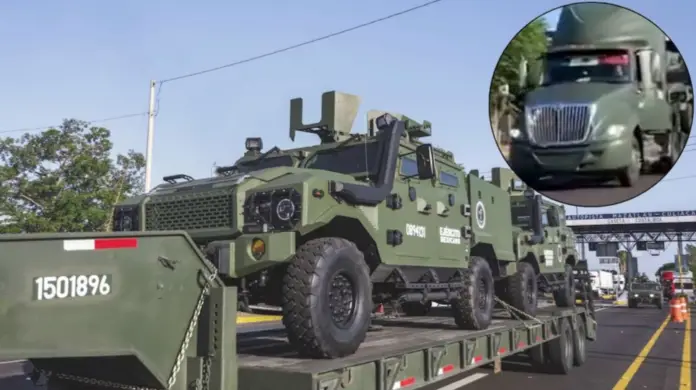
This Thursday, as part of the strategy to combat the recent violence in Sinaloa, the Ministry of National Defense (Sedena) deployed 10 Ocelot armored vehicles in Culiacán and 100 elements of the Mexican Army.
This measure was taken in response to the escalation of violence between the factions of the Sinaloa Cartel, Los Chapitos and La Mayiza, whose conflict began on September 9 and has left 187 intentional homicides.
These Ocelot vehicles, also known as VE.RE. (Reconnaissance Vehicle), were specifically designed for the Sedena for use in operations in both rural and urban areas. Equipped with armor resistant to high-caliber weapons and explosives, capacity for 11 passengers and a diesel engine that allows them to travel long distances without needing to refuel, the Ocelots represent an essential part of the efforts to contain violence in the region.
However, the arrival of these vehicles was not without controversy. Images and videos of the military convoy carrying the Ocelots began to circulate on social media.
One of these images generated controversy due to a particular detail: a trailer carrying one of these armored vehicles showed a small cowboy hat hanging from the windshield.
This hat was quickly associated with the La Mayiza faction, a group known for using hats of this type as a symbol in honor of the co-founder of the Sinaloa Cartel, Ismael El Mayo Zambada, who was arrested in the United States on July 25.
The symbolism of the hat
In many parts of Mexico, the cowboy hat is a common symbol, used by people with no connection to criminal groups. However, the connection of this type of hat with the La Mayiza faction, led by Ismael Zambada Sicairos, alias El Mayito Flaco and son of El Mayo who is also called “El Señor del Sombrero” has been widely documented, both by authorities and by journalists specializing in drug trafficking.
In recent months, hats have been found on corpses of victims of this faction, which has reinforced its symbolic connotation within the internal war of the Sinaloa Cartel.
The symbol used by the rival faction of “La Chapiza”, led by the sons of Joaquín “El Chapo” Guzmán, is the pizza. This emblem was adopted due to a play on words with the name of the group, since “La Chapiza” sounds similar to “Cha-pizza”. The pizza has appeared in narco-messages and at crime scenes, even in cases where bodies have been left next to pizza boxes. It has also been used on social media and in music, such as in the song “Ch y la Pizza” performed by Fuerza Regida and Natanael Cano.
According to journalist Luis Chaparro, a member of the Mexican Army explained that the “cavalry”, the unit in charge of the armored equipment, uses hats as part of its uniform, which would give an idea of why that hat pendant was on the unit.
However, Chaparro added that it is well known that this type of hat has a specific symbolism, especially in the context of violence currently being experienced in the state.
Only a few days before this controversial photograph was taken, on October 3, five bodies were discovered at the southern exit of Culiacán, Sinaloa, in a scene that was widely shared on social media. The bodies were found on the Calzada Heroico Colegio Militar, in the vicinity of the Motel Sensación and near the Jardines del Humaya cemetery. The victims, dressed in light clothing, were found barefoot, with signs of torture and with hats placed on their heads.
This discovery is just one of many that have taken place since the outbreak of the Sinaloa Cartel’s internal war.
The Sinaloa government, headed by Governor Rubén Rocha Moya, has coordinated efforts with the Sedena and the Secretariat of Security and Citizen Protection (SSPC) to reinforce security in the state. In addition to the Ocelot vehicles, 100 elements of the Mexican Army Special Forces were deployed in the state to support security efforts, along with the arrival of reinforcements from the National Guard from other states.
The situation in Culiacán remains tense, with the civilian population caught in the middle of the violence. The war between Los Chapitos and La Mayiza has affected not only those directly involved, but also the communities that live in constant fear of being victims of the brutality of the conflict.
Sorce: infobae






